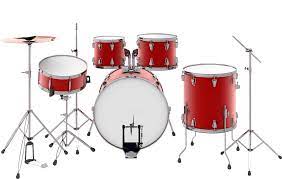
"The Rhythmic Heartbeat: Exploring the Dynamic World of Drums"
In the intricate tapestry of musical instruments, the drums stand as the heartbeat—the driving force that infuses energy, dynamism, and raw emotion into the symphony of sound. From ancient civilizations to modern genres, drums have been an integral part of human culture, weaving a rhythmic narrative that transcends boundaries. Let's dive into the world of drums—unveiling their diverse forms, cultural significance, and powerful presence across musical landscapes.
Origins and Evolution:
Drums have an ancient lineage, dating back thousands of years across various cultures worldwide. From simple hand-held frame drums to elaborate percussion ensembles, these instruments have evolved in design and purpose, reflecting the unique rhythms and traditions of different societies.
Diversity of Forms:
Drums come in various shapes, sizes, and materials. The Djembe from West Africa, the Taiko drums from Japan, the Tabla from India, the Congas from Cuba, and the Drum Kit from modern popular music—all embody the diversity and versatility of drums, each with its unique tonal qualities and playing techniques.
Rhythmic Expressions:
The essence of drums lies in their ability to communicate without words—to express emotions, tell stories, and set the pulse of music. Drummers harness the instrument's power, employing intricate rhythms, patterns, and dynamics to create layers of sonic textures.
Cultural Significance:
In many cultures, drums are deeply intertwined with rituals, ceremonies, and social gatherings. They serve as a means of communication, celebration, and spiritual connection, symbolizing unity, resilience, and the heartbeat of communities.
Technological Innovation:
In the modern era, drums have undergone technological advancements, giving rise to electronic drum kits and synthesized percussion sounds. These innovations have expanded the sonic possibilities, enabling drummers to explore new realms of creativity and experimentation.
Drummers as Maestros:
Throughout history, master drummers have left an indelible mark on the world of music. Icons like Ginger Baker, Buddy Rich, Zakir Hussain, and Sheila E. have showcased the technical prowess and artistic depth of drumming, inspiring generations of musicians.
Unity in Diversity:
Despite their myriad forms and functions, drums share a common language—a universal rhythm that transcends cultural barriers. They serve as a unifying force, bringing people together in concerts, festivals, and collaborative musical endeavors.
Conclusion: The Pulsating Soul of Music
In the symphony of musical instruments, drums stand as the heartbeat—the rhythmic soul that pulses through melodies, harmonies, and silences. They embody the primal energy of humanity's collective heartbeat, echoing through time as a testament to our innate connection to rhythm and expression.
As drummers unleash their beats, whether in ancient rituals, orchestral compositions, or contemporary genres, they carry forward the legacy of an instrument that is not just heard but felt—a powerful testament to the vibrant, pulsating spirit of music itself.
The drums' ability to unify, express, and energize makes them an essential force in the world of music, embodying the primal essence of rhythm and expression.
ABOUT AUTHOR : Musicintuit Admin
EXPLORE OUR ARRAY OF ONLINE MUSIC COURSES: Musicintuit Courses
ENROLL TODAY ! EXPLORE AND IMMERSE YOURSELF IN THE REALM OF MUSIC: Contact Musicintuit




